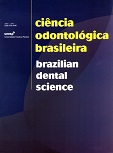Morphological analysis of gutta-percha points subjected to different treatments and influence on sealing the filling
DOI:
https://doi.org/10.14295/bds.2012.v15i3.800Keywords:
Peracetic acid, Chlorhexidine, Gutta-percha, Sodium hypochlorite, Dental leakage.Abstract
Objective: This study evaluated the morphological changes in scanning electron microscopy (SEM), which occur on the surface of gutta-percha points at times exceeded those recommended. Methods: 2% chlorhexidine (CLX), 2.5% sodium hypochlorite (NaOCl), 2%peracetic acid (PA) and 0.25% peracetic acid (SAP) solutions were used in periods of 1 minute, 30 minutes, 6 hours and 12 hours. Groups were divided according to the solution and disinfection period (n=12). Results: The results indicated that there was statistically significant difference between the solutions and periods tested. In 1 minute, all solutions do not differ from the control. After 30 minutes, the SAP significantly alter the morphology of the points. The test energy dispersive spectrometry (EDS) indicated that all the solution periods alter the chemical composition of gutta-percha points. The relationship of disinfection on microleakage of filling was also evaluated in groups that suffered disinfection for 12 hours. The SAP group showed statistically significant difference compared to control, because 100% of its roots showed infiltration. The other groups of CLX, NaOCl and AP, although not statistically significant, were respectively 9, 8 and 8 out of 12 of his roots with infiltration. Conclusion: Concluded that the disinfection process can cause morphological changes if the immersion period is exceeded and that, in addition to altering the chemical composition of gutta-percha, these solutions can influence the sealing of the filling.
Downloads
Downloads
Additional Files
Published
How to Cite
Issue
Section
License
Brazilian Dental Science uses the Creative Commons (CC-BY 4.0) license, thus preserving the integrity of articles in an open access environment. The journal allows the author to retain publishing rights without restrictions.
=================
COPYRIGHT TRANSFER AND RESPONSIBILITY STATEMENT
(PDF)
For all articles published in the BDS journal, copyright is retained by the authors. Articles are licensed under an open-access Creative Commons CC BY 4.0 license, meaning that anyone may download and read the paper for free. In addition, the article may be reused and quoted, provided that the original published version is cited. These conditions allow for maximum use and exposure of the work while ensuring that the authors receive proper credit. All metadata associated with published articles is released under the Creative Commons CC0 Universal Public Domain Dedication.
Before the submission, authors must obtain permission to reproduce any published material (figures, schemes, tables, or any extract of a text) that does not fall into the public domain or for which they do not hold the copyright. Permission should be requested by the authors from the copyright holder (usually the Publisher, please refer to the imprint of the individual publications to identify the copyright holder).
The authors hereby attest that the study is original and does not present manipulated data, fraud, or plagiarism. All names listed made a significant scientific contribution to the study, are aware of the presented data, and agree with the final version of the manuscript. They assume complete responsibility for the ethical aspects of the study.
This text must be printed and signed by all authors. The scanned version should be submitted as supplemental file during the submission process.






























